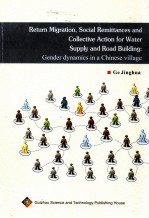

返乡流动、社会性汇寄与供水和道路建设集体行动 一个村庄中的性别动力学研究PDF电子书下载
- 电子书积分:10 积分如何计算积分?
- 作 者:葛菁华编著
- 出 版 社:贵阳:贵州科技出版社
- 出版年份:2012
- ISBN:7806629661
- 页数:224 页
Chapter 1 Introduction 1
1.1 Background 1
1.2 Statement of the Research Problem 5
1.3 Research Objectives 7
1.4 Research Questions 7
1.5 Rationale of the Study 8
1.6 Conceptional Framework 12
1.7 Contribution and Significance of this Study 16
1.8 The Thesis and its Structure 18
Chapter 2 Literature Review 20
2.1 Gender and Migration:Debates and Insights 20
2.1.1 Neo-classical migration theories 21
2.1.2 Political economy/structuralist 24
2.1.3 Structuration/structure-agency 28
2.1.4 Transnationalism and translocalism 33
2.1.5 A reinvigorated feminist political ecology 36
2.2 Migration,Gender and Environment:Linkages 39
2.2.1 Remittance and gender-impacts on natural resource management/resource use 39
2.2.2 Mediations in natural resources management/resource use 43
2.2.3 Migration,gender and natural resources management 49
2.3 Collective Action,Leadership and Social Remittances 50
2.4 Rural-Urban Migration in China 52
2.4.1 Social differentiations within rural societies 52
2.4.2 Social networks and social remittances 53
2.4.3 Gender dimension in understanding rural-urban migration in China 54
2.4.4 Social impacts of return migrants on sending areas 56
2.5 Social Institutions in China 57
Chapter 3 Methodology 59
3.1 Background on the Research Project 59
3.2 Qualitative Approach to Research 60
3.3 Data Collection Techniques 61
3.3.1 Secondary data 61
3.3.2 Primary data 61
3.4 Triangulations,Reflections and Validations 68
3.5 Data Analysis 69
3.6 Researcher's Role 70
Chapter 4 Wider Context of Change in China:Economy,Migration and Gender 72
4.1 Introduction 72
4.2 Economic Development and Migration 72
4.3 Collectivization,Household Contract Responsibility System(HCRS),Migration and Gender 74
4.3 Easing up rural-urban migration 74
4.3.2 Gender regimes during and after collectivization 77
4.4 The hukou System:The Reasons behind Circular Migration 79
4.5 Contemporary Migration in China 81
4.5.1 Phases 81
4.5.2 Scales and trends 81
4.5.3 Receiving and sending areas 82
4.5.4 Conditions in cities 83
4.5.5 Return migration and its social influence 83
4.6 Discussion 84
Chapter 5 Study Site:Gender,Livelihoods,Migration and Collective Actions 86
5.1 Introduction 86
5.2 Background on the Site under Study 86
5.2.1 Location of village 86
5.2.2 Village population and migrants 88
5.2.3 Village kinship and marriage system 89
5.3 Livelihood,Gender and Migration 91
5.3.1 Village Livelihoods 91
5.3.2 Gender relations within household and its changes 99
5.4 Village Migration and Gender 107
5.4.1 Contemporary migration and its gender implications 107
5.4.2 Returnees'profiles and gender 109
5.4.3 Social remittances from migration by gender 111
5.5 Resource Rights and Public Goods Provision 113
5.5.1 Exclusion and inclusion in user rights,entitlements and gender 113
5.5.2 Shifting public goods provision paradigm 114
5.6 Collective Action for Livelihood Improvement 116
5.6.1 Spontaneous collective road building 116
5.6.2 Participatory water tanks construction and management 117
5.7 Impacts of Collective Action on Natural Resources and its Management 125
5.8 Discussion 126
Chapter 6 Return Migration and Their Social Resources in Collective Road Building 129
6.1 Introduction 129
6.2 Migrant Social Remittances and Collective Action in Road Building 129
6.2.1 The possibility of a road 129
6.2.2 Pooling resources 132
6.2.3 Rule-making for labor organization 135
6.3 Changing the Ways of Leadership in the Context of Rural Migration 137
6.4 Discussion:Investing Social Capital and Re-asserting Gender,Kin and Migrant Identities for Collective Road-building 139
Chapter 7 Migrant Returnees in Village Politics and Collective Water Tanks Construction and Management 149
7.1 Introduction 149
7.2 Social Remittances in Water Tank Construction and Management 149
7.3 Male-centric Employment of Social Remittances 151
7.4 Support from the Rear 156
7.5 Gendered Kinship Support 162
7.6 Gendered Struggle for Water Access:I Am Drinking Lijia's Water 165
7.7 Younger Migrant Returnees and Their Kinship Positions 169
7.8 Discussion:Gender and Kinship in Collective Action and Village Politics 173
Chapter 8 Main Findings,Discussions and Conclusions 176
8.1 Main Findings 176
8.1.1 Circular migration in the study site 177
8.1.2 Received social remittances in promoting village conective action 178
8.1.3 Harnessing of social remittances and gender dynamics of collective action 178
8.1.4 Effects of social remittances on local social and gender hierarchies 180
8.2 Discussion 183
8.2.1 Dynamics at the macro level 183
8.2.2 Changes in gender relations 189
8.2.3 De-collectivization and gender 192
8.3 Conclusions 194
8.3.1 Migration and gender 194
8.3.2 Gender and natural resource management 195
8.3.3 Redefining social remittance as a process in gender and migration studies 196
8.3.4 Capital,politics,society and gender 197
8.3.5 Recommendations for policy action 198
References 199
Appendix 1 Checklist for key informant interviews 214
2 Checklist for focus group discussions 215
3 Checklist for semi-structured individual interviews 216
4 Questionnaire for Household Survey 218
- 《红色旅游的社会效应研究》吴春焕著 2019
- 《社会学与人类生活 社会问题解析 第11版》(美)James M. Henslin(詹姆斯·M. 汉斯林) 2019
- 《凯恩斯文集 第13卷 社会、政治和文学论集》严忠志译 2018
- 《社会资本与村庄治理转型的社区机制》张国芳等著 2019
- 《生态文化建设的社会机制研究》阮晓莺著 2019
- 《空气动力学 7 飘浮的秘密》(加)克里斯·费里著 2019
- 《社会文化系统中的翻译》姜秋霞,杨正军 2019
- 《中国退役动力电池循环利用技术与产业发展报告》中国科学院过程工程研究所,资源与环境安全战略研究中心,中国物资再生协会编著 2019
- 《社会工作专业英语》俞炎燊 2019
- 《评弹与江南社会研究丛书 梅与竹 中国传统苏州评弹》李东鹏译;(美国)马克·本德尔 2019
- 《市政工程基础》杨岚编著 2009
- 《家畜百宝 猪、牛、羊、鸡的综合利用》山西省商业厅组织技术处编著 1959
- 《《道德经》200句》崇贤书院编著 2018
- 《高级英语阅读与听说教程》刘秀梅编著 2019
- 《计算机网络与通信基础》谢雨飞,田启川编著 2019
- 《看图自学吉他弹唱教程》陈飞编著 2019
- 《法语词汇认知联想记忆法》刘莲编著 2020
- 《培智学校义务教育实验教科书教师教学用书 生活适应 二年级 上》人民教育出版社,课程教材研究所,特殊教育课程教材研究中心编著 2019
- 《国家社科基金项目申报规范 技巧与案例 第3版 2020》文传浩,夏宇编著 2019
- 《流体力学》张扬军,彭杰,诸葛伟林编著 2019
- 《贵州省志 1978-2010 卷10 民政》贵州省地方志编纂委员会编 2018
- 《丹砂古寨 贵州务川龙潭仡佬族村民族志研究》李劲松著 2019
- 《科技语篇翻译教程》雷晓峰,李静主编 2020
- 《中国民间美术遗产普查集成 贵州卷 上》冯骥才主编;余未人分册主编 2007
- 《贵州大数据发展与建设》张梅,文静华,刘振 2019
- 《中国民间美术遗产普查集成 贵州卷 下》冯骥才主编;余未人分册主编 2007
- 《贵州省煤层气地面抽采关键技术与工程应用》易同生,桑树勋,金军主编;周效志,汪凌霞,陈捷等副主编 2019
- 《上海市订购外国和港台科技期刊联合目录 1983 上》上海科学技术情报研究所 1983
- 《我与贵州改革开放40年》贵州日报当代融媒体集团,中国党刊网编 2019
- 《贵州蓝皮书 贵州国有企业社会责任发展报告》郭丽主编 2019
